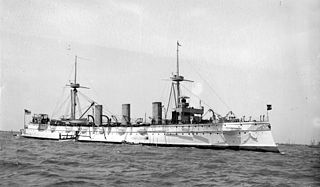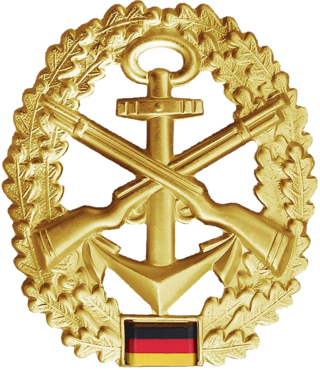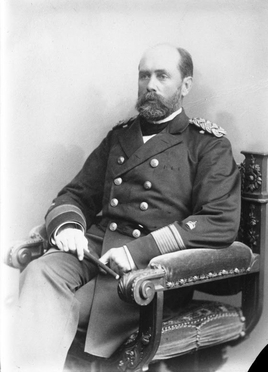
A Marine expeditionary unit is the smallest air-ground task force (MAGTF) in the United States Fleet Marine Force. Each MEU is an expeditionary quick reaction force, deployed and ready for immediate response to any crisis, whether it be natural disaster or combat mission. Marine amphibious unit (MAU) was the name used until the late 1980s.

Jäger is a German military term referring to specific light infantry units.

The Marinebrigade Ehrhardt, also known as the Ehrhardt Brigade, was a Freikorps unit of the early Weimar Republic. It was formed on 17 February 1919 as the Second Marine Brigade from members of the former Imperial German Navy under the leadership of Hermann Ehrhardt. The Brigade was used primarily in the suppression of the Bavarian Soviet Republic and the First Silesian Uprising, both in the first half of 1919. In March 1920, faced with its imminent disbanding by orders of the government in Berlin, the Marine Brigade was one of the main supporters of the Kapp Putsch that tried to overthrow the Weimar Republic. After the putsch failed and the Brigade was disbanded in May, many of the former members formed the secret Organisation Consul under Ehrhardt's leadership. Before it was banned in 1922, it carried out numerous assassinations and murders in a continuation of the attempts to overthrow the Republic.

The German East Asia Squadron was an Imperial German Navy cruiser squadron which operated mainly in the Pacific Ocean between the mid-1890s until 1914, when it was destroyed at the Battle of the Falkland Islands. It was based at Germany's Jiaozhou Bay Leased Territory in China.

The Eight-Nation Alliance was a multinational military coalition that invaded northern China in 1900 with the stated aim of relieving the foreign legations in Beijing, then besieged by the popular Boxer militia, who were determined to remove foreign imperialism in China. The Allied forces consisted of about 45,000 troops from the eight nations of Germany, Japan, Russia, Britain, France, the United States, Italy, and Austria-Hungary. Neither the Chinese nor the quasi-concerted foreign allies issued a formal declaration of war.

Marines, or naval infantry, are typically a military force trained to operate in littoral zones in support of naval operations. Historically, tasks undertaken by marines have included helping maintain discipline and order aboard the ship, the boarding of vessels during combat or capture of prize ships, and providing manpower for raiding ashore in support of the naval objectives. In most countries, the marines are an integral part of that state's navy.

The United States Marine Corps is organized within the Department of the Navy, which is led by the Secretary of the Navy (SECNAV). The most senior Marine commissioned officer is the Commandant of the Marine Corps, responsible for organizing, recruiting, training, and equipping the Marine Corps so that it is ready for operation under the command of the unified combatant commanders. The Marine Corps is organized into four principal subdivisions: Headquarters Marine Corps, the Operating Forces, the Supporting Establishment, and the Marine Forces Reserve.

The Ukrainian Naval Infantry Corps, also known as the Ukrainian Marines, is part of coastal defense troops of the Ukrainian Navy. It is used as a component part of amphibious, airborne and amphibious-airborne operations, alone or in coordination with formations and units of the Army in order to capture parts of the seashore, islands, ports, fleet bases, coast airfields and other coast objects from the enemy. It can also be used to defend naval bases, vital shoreline areas, separate islands and coast objects, and security of hostile areas.

The Naval Infantry Command, also known as the Naval Infantry of the Navy of the Argentine Republic and generally referred to in English as the Argentine marines are the amphibious warfare branch of the Argentine Navy and one of its four operational commands.

The Lagunari Regiment "Serenissima" is the an active unit of Italian Army's infantry arm's amphibious Lagunari speciality. The name of the specialty comes from the Italian word for lagoon, while the regiment's name "Serenissima" commemorates the Most Serene Republic of Venice. The regiment is based in Venice and assigned to the Cavalry Brigade "Pozzuolo del Friuli". The "Pozzuolo del Friuli" brigade forms, together with the Italian Navy's Third Naval Division and San Marco Marine Brigade, the Italian Armed Forces' Sea Projection Force.

SMS Kaiserin Augusta was a unique protected cruiser, built for the German Kaiserliche Marine in the early 1890s. Named for Empress Augusta, who died in January 1890, she was laid down in 1890, launched in January 1892, and completed in November of that year. Owing to budgetary restrictions, Kaiserin Augusta was designed to fill both fleet scout and colonial cruiser roles. The ship was initially armed with a main battery of four 15 cm (5.9 in) and eight 10.5 cm (4.1 in) guns, which by 1896 was replaced with twelve new model 15 cm guns. She was the first ship in the German Navy to feature a three-shaft propeller arrangement.
The United States Marine Corps is tasked by Department of Defense directive to "conduct complex expeditionary operations in the urban littorals and other challenging environments" and "conduct amphibious operations, including engagement, crisis response, and power projection operations to assure access." Before 2006, the Marine Corps was the only branch of the Armed Forces that did not have any of its special warfare elements participating in the United States Special Operations Command (USSOCOM), due to confining its special operations capabilities only for the purpose to the Fleet Marine Force.
The reconnaissance mission within the United States Marine Corps is divided into two distinct but complementary aspects; Marine Division Recon and Force Reconnaissance.

The Naval Protection Force was a marine unit of the German Navy. It had the size of a Battalion and was part of the 1st Flotilla. It was established on April 1, 2005, but traces its roots back to 1958, when the so-called Sea battalion (Seebataillon) was activated. Its headquarters was in Eckernförde on the Baltic Sea. Next to the Naval Special Deployment Force, the Naval Protection Force were considered to be a marine element within the German Navy.

The Jiaozhou Bay Leased Territory was a German leased territory in Imperial and Early Republican China from 1898 to 1914. Covering an area of 552 km2 (213 sq mi), it centered on Jiaozhou Bay on the southern coast of the Shandong Peninsula. The administrative center was at Qingdao. It was operated by the East Asia Squadron of the Imperial German Navy. The Russian Empire resented the German move as an infringement on Russian ambitions in the region.

Ernst Otto von Diederichs was a German admiral during the period of New Imperialism.
The German special forces include the Special Operations Command of the German Army and the Naval Special Forces Command of the German Navy. Both are regular units and fully integrated into the branches of the German Armed Forces. During operations, special forces personnel are under the command of the special operations division of the Bundeswehr Joint Operations Command in Potsdam, a branch of the Joint Support LlslkekService (Streitkräftebasis).

SMS Irene was a protected cruiser or Kreuzerkorvette of the German Imperial Navy and the lead ship of the Irene class. She had one sister, Prinzess Wilhelm; the two ships were the first protected cruisers built by the German Navy. Irene was laid down in 1886 at the AG Vulcan shipyard in Stettin, launched in July 1887, and commissioned into the fleet in May 1888. The cruiser was named after Princess Irene of Hesse and by Rhine, sister-in-law of Kaiser Wilhem II. As built, the ship was armed with a main battery of fourteen 15 cm (5.9 in) guns and had a top speed of 18 knots.

SMS Arcona was a member of the Carola class of steam corvettes built for the German Kaiserliche Marine in the 1880s. Intended for service in the German colonial empire, the ship was designed with a combination of steam and sail power for extended range, and was equipped with a battery of ten 15-centimeter (5.9 in) guns. Arcona was laid down at the Kaiserliche Werft in Danzig in 1881, she was launched in May 1885, and she was completed in December 1886.






















